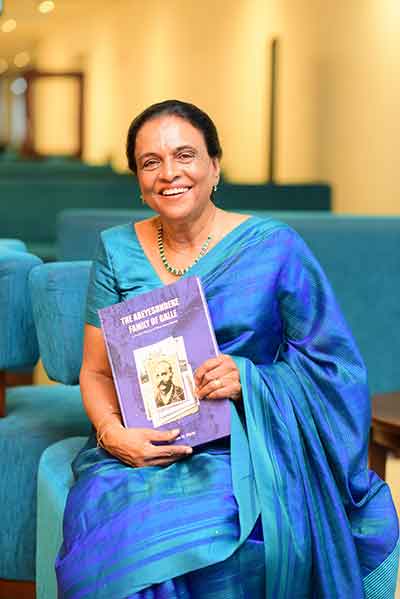
Nov 25 2025.
views 145
 Every family has a story tucked between generations, some stretching so far back that they slip into obscurity, like a pearl beneath the tides, waiting for someone to notice its glow. When Dr Nirmala M. Pieris decided to trace the path of the Abeyesundere lineage of Galle, she was stepping into a narrative that demanded to be remembered. Her new book, The Abeyesundere Family of Galle, launched on the 14th of November 2025, becomes the first deep and carefully woven account of a family whose notable influence shaped communities, churches, and countless lives across more than two centuries (1805-2025). What began as a simple curiosity evolved into a journey that bridges the past with the present and reminds us why heritage still matters.
Every family has a story tucked between generations, some stretching so far back that they slip into obscurity, like a pearl beneath the tides, waiting for someone to notice its glow. When Dr Nirmala M. Pieris decided to trace the path of the Abeyesundere lineage of Galle, she was stepping into a narrative that demanded to be remembered. Her new book, The Abeyesundere Family of Galle, launched on the 14th of November 2025, becomes the first deep and carefully woven account of a family whose notable influence shaped communities, churches, and countless lives across more than two centuries (1805-2025). What began as a simple curiosity evolved into a journey that bridges the past with the present and reminds us why heritage still matters.
To step closer to the soul of this story, we turned to Dr Nirmala's reflections, as she unfolded the discoveries and quiet truths that shaped this timeless project.
The inspiration came from the many Abeyesundere family gatherings we had in recent years. Despite these get-togethers, most of us knew very little about our own heritage beyond the fact that Pemyano William Abeyesundere, my great-great-grandfather, was a key ancestor and a well-known philanthropist in Galle. I became increasingly curious to learn more about the family’s history, especially because my maternal grandmother was an Abeyesundere, and her father, Fred Abeyesundere, was the son of William Abeyesundere. This personal connection motivated me to explore and document the family story more deeply, especially since the Abeyesundere legacy had never been formally recorded before.
In my storytelling, I sought to capture Galle’s spirit by highlighting the Abeyesundere family’s significant role in its social and historical development. Their contributions include the Catholic church in Halpathota in the Galle District, consecrated in 1898, built entirely at William Abeyesundere’s expense on land he donated to the Diocese of Galle. His son, Fred, continued this legacy by supporting St Lucia’s Church in Ketapola near Galle. The family also donated land in Galle for the Van Reeth Memorial Home for elders in 1927, where Fred funded the William Abeyesundere Ward. Their 25 years of continuous, combined service on the Galle Municipal Council and the Abeyesundere Mawatha in Galle, all of which honour their enduring impact.
Yes, there were several challenges during my research. The first was uncovering the family’s roots and finding reliable information on William Abeyesundere’s parents. I eventually identified his father, Abraham Abeyesundere (born around 1805), and his mother, Nathalia Wijewickreme, through an 1857 church archive. Establishing the number and order of William’s children was another difficulty, which I confirmed through his Last Will. Tracing the family across 220 years and nine generations required extensive work with church archives, official records, cemetery gravestones and oral accounts, including many demanding cemetery visits. Along the way, I encountered surprising discoveries, some moving, others humorous. The writing process also required continual research to fill in gaps.
The key message is a deeper awareness of the Abeyesundere family and its previously unknown members, helping readers recognise these ancestors as part of their extended family. Emotionally, it highlights the bonds and connections beyond immediate circles, allowing younger generations to discover that some friends and acquaintances are, in fact, relatives.
The Abeyesundere family’s story reflects Sri Lankan society by highlighting strong family bonds, respect for elders, and the importance of social contacts. It shows the balance between traditional and modern values, while emphasising loyalty, duty, and collective decision-making. Their experiences mirror broader Sri Lankan values, where family ties are central to daily life.
My background as a scientist and analytical chemist greatly influenced my writing. I approached every piece of information critically, verifying details through research findings, direct interactions with family members or reliable sources. Nothing was taken at face value, as I relied on careful analysis and evidence to ensure accuracy and depth in portraying the story.
After this intensive research and writing journey from January 2024 to July 2025, I plan to take a short break. My next project will be a cookery book featuring my own recipes, created especially for my grandchildren, Anithra, Kiyana, Dineth, Jaanya, and Nireka, who always love and enjoy the food I make for them.
Finally, I would like to express my heartfelt thanks to everyone who was part of this journey. My special gratitude to my husband, Mevan Pieris, for planting the seed for this book and for our countless discussions; my lifelong friend, Dilmani Warnasuriya, for meticulously editing the manuscript; Rev. Fr Bede De Silva, Parish Priest of our ancestral church, Our Lady of Lourdes in Halpathota, for supporting my research in Galle; and my two children, Dilani and Nilanka, for their wholehearted support at every step of this journey.
For enquiries, please contact +94 773 097798
0 Comments